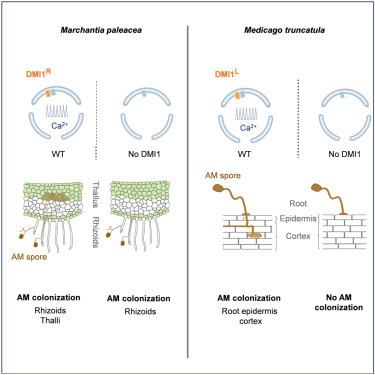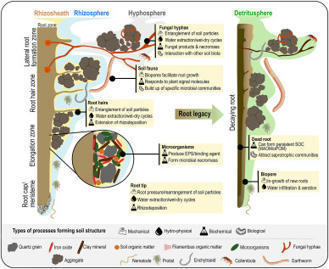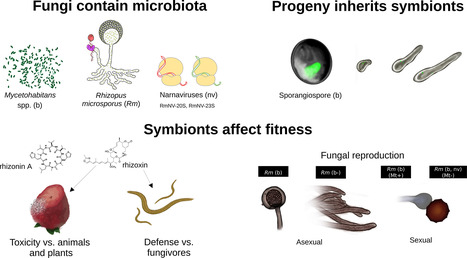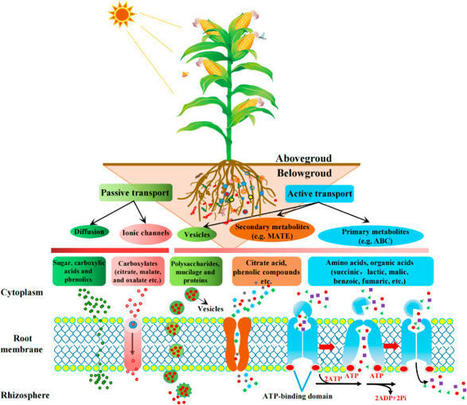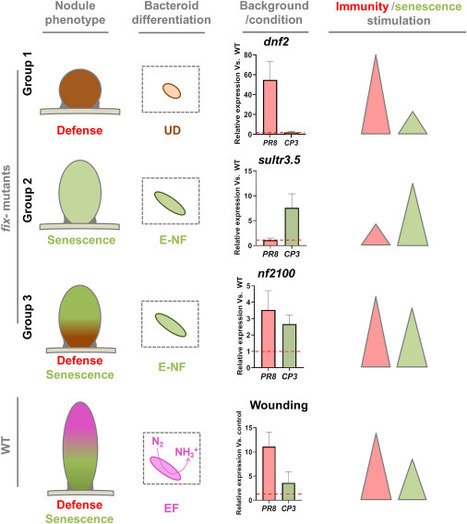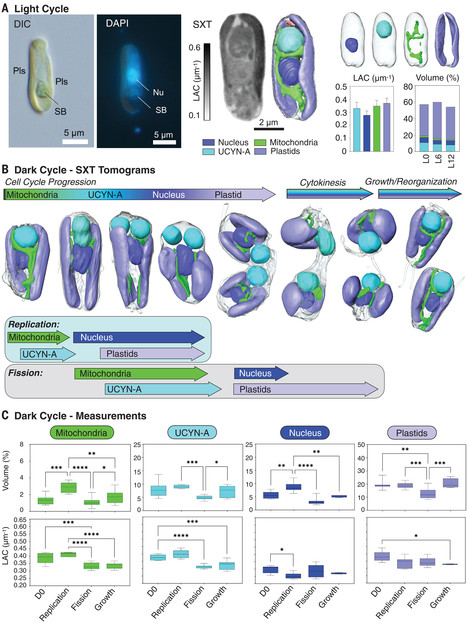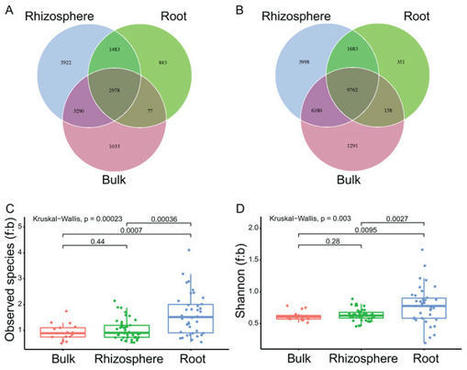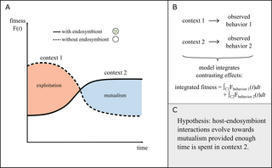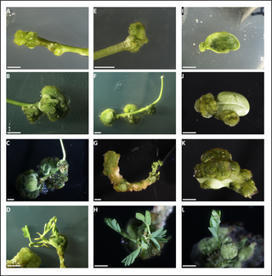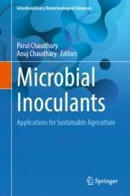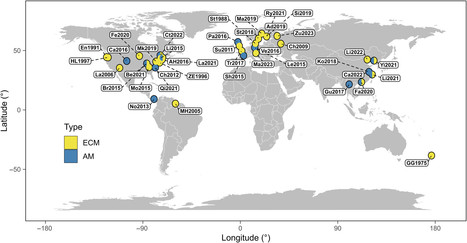 Your new post is loading...
 Your new post is loading...
The ability of fungi to establish mycorrhizal associations with plants and enhance the acquisition of mineral nutrients stands out as a key feature of terrestrial life. Evidence indicates that arbuscular mycorrhizal (AM) association is a trait present in the common ancestor of land plants,1,2,3,4 suggesting that AM symbiosis was an important adaptation for plants in terrestrial environments.5 The activation of nuclear calcium signaling in roots is essential for AM within flowering plants.6 Given that the earliest land plants lacked roots, whether nuclear calcium signals are required for AM in non-flowering plants is unknown. To address this question, we explored the functional conservation of symbiont-induced nuclear calcium signals between the liverwort Marchantia paleacea and the legume Medicago truncatula. In M. paleacea, AM fungi penetrate the rhizoids and form arbuscules in the thalli.7 Here, we demonstrate that AM germinating spore exudate (GSE) activates nuclear calcium signals in the rhizoids of M. paleacea and that this activation is dependent on the nuclear-localized ion channel DOES NOT MAKE INFECTIONS 1 (MpaDMI1). However, unlike flowering plants, MpaDMI1-mediated calcium signaling is only required for the thalli colonization but not for the AM penetration within rhizoids. We further demonstrate that the mechanism of regulation of DMI1 has diverged between M. paleacea and M. truncatula, including a key amino acid residue essential to sustain DMI1 in an inactive state. Our study reveals functional evolution of nuclear calcium signaling between liverworts and flowering plants and opens new avenues of research into the mechanism of endosymbiosis signaling.
Plants and microorganisms establish beneficial associations that can improve their development and growth. Recently, it has been demonstrated that bacteria isolated from the skin of amphibians can contribute to plant growth and defense. However, the molecular mechanisms involved in the beneficial effect for the host are still unclear. In this work, we explored whether bacteria isolated from three tropical frogs species can contribute to plant growth. After a wide screening, we identified three bacterial strains with high biostimulant potential, capable of modifying the root structure of Arabidopsis thaliana plants. In addition, applying individual bacterial cultures to Solanum lycopersicum plants induced an increase in their growth. To understand the effect that these microorganisms have over the host plant, we analysed the transcriptomic profile of A. thaliana during the interaction with the C32I bacterium, demonstrating that the presence of the bacteria elicits a transcriptional response associated to plant hormone biosynthesis. Our results show that amphibian skin bacteria can function as biostimulants to improve agricultural crops growth and development by modifying the plant transcriptomic responses.
Symbiotic nitrogen fixation (SNF) facilitated by the interaction between legumes and rhizobia is a well-documented and eco-friendly alternative to chemical nitrogen fertilizers. Host plants obtain fixed nitrogen from rhizobia by providing carbon and mineral nutrients. These mineral nutrients, which are mostly in the form of metal ions, are implicated in various stages of the SNF process. This review describes the functional roles played by metal ions in nodule formation and nitrogen fixation and specifically addresses their transport mechanisms and associated transporters within root nodules. Future research directions and potential strategies for enhancing SNF efficiency are also discussed.
Symbiosis is a puzzle: seemingly in defiance of the view that biological organisms are selfish entities, nature has provided numerous examples of distantly related species “working together.” These ecological interactions have been fundamental to the emergence of Earth’s biological systems, for example, driving how eukaryotic cells evolved [1], how plants colonized the terrestrial biome [2], and how coral reef ecosystems are built [3]. Yet scratch below the surface, and collaborations between species are never fully cooperative. Many interactions remain transient maximizations of ecological, metabolic, or protective benefit. Even in long-established endosymbioses, in which a microbial symbiont lives within cells of the host, selection drives each species to evolve in directions that are often to their partner’s detriment [4]. Consequences for symbionts can include entrapment, genetic appropriation, genome reduction, loss of autonomy, expulsion, and being digested. And, from the host side, symbiosis can lead to obligate dependence on partners that are erratically present or that are mutation ridden and ecologically fragile. Such dynamics might appear to make these interactions inherently unstable, yet they arise frequently and often persist across considerable periods of time and many generations.
A group of Gram-negative plant-associated diazotrophic bacteria belonging to the genus Nitrospirillum was investigated, including both previously characterized and newly isolated strains from diverse regions and biomes, predominantly in Brazil. Phylogenetic analysis of 16S rRNA and recA genes revealed the formation of a distinct clade consisting of thirteen strains, separate from the formally recognized species N. amazonense (the closest species) and N. iridis. Comprehensive taxonomic analyses using the whole genomes of four strains (BR 11140T = AM 18T = Y-2T = DSM 2788T = ATCC 35120T, BR 11142T = AM 14T = Y-1T = DSM 2787T = ATCC 35119T, BR 11145 = CBAmC, and BR 12005) supported the division of these strains into two species: N. amazonense (BR 11142 T and BR 12005) and a newly proposed species (BR 11140 T and BR 11145), distinct from N. iridis. The phylogenomic analysis further confirmed the presence of the new Nitrospirillum species. Additionally, MALDI-TOF MS analysis of whole-cell mass spectra provided further evidence for the differentiation of the proposed Nitrospirillum species, separate from N. amazonense. Analysis of chemotaxonomy markers (i.e., genes involved in fatty acid synthesis, metabolism and elongation, phospholipid synthesis, and quinone synthesis) revealed that the new species highlights high similarity and evolutionary convergence with other Nitrospirillum species. This new species exhibited nitrogen fixation ability in vitro, it has similar NifHDK protein phylogeny position with the closest species, lacked denitrification capability, but possessed the nosZ gene, enabling N2O reduction, distinguishing it from the closest species. Despite being isolated from diverse geographic regions, soil types, and ecological niches, no significant phenotypic or physiological differences were observed between the proposed new species and N. amazonense. Based on these findings, a new species, Nitrospirillum viridazoti sp. nov., was classified, with the strain BR 11140T (DSM 2788T, ATCC 35120T) designated as the type strain.
• Plant roots are inherently bound to soil structure dynamics through rhizosphere processes.
• Rhizodeposits and root hairs trigger rhizosheath formation through multiple routes.
• Roots foster formation of unique habitat by affecting soil porosity and aggregation.
• Soil fauna and legacy of dead roots are overlooked factors for rhizosphere structure formation and stability.
•Bridging solid phase and pore scale research needed to advance rhizosphere research.
Rhizopus microsporus is an example of a fungal holobiont. Strains of this species can harbor bacterial and viral endosymbionts inherited by the next generation. These microbial allies increase pathogenicity and defense and control asexual and sexual reproduction.
In this work, we analyzed the effect of water stress and acid pH on the growth of the endemic fodder legume Chamaecytisus albidus, inoculated with four strains of Bradyrhizobium, from three different symbiovars previously isolated from the plant grown in different eco-geographical areas of Morocco. We also assessed the competitiveness of the three symbiovars for plant nodulation under water stress and acidity. We analyzed the strain’s nodulation ability, rates of nodules occupancy, shoot, and root dry weights of plants grown at -100, -80, and − 60 MPa water potential, and 6.0 and 7.0 pH values. The strains CM64 and CJ2 belong to the symbiovar genistearum and strains CA20 and CB10 to the symbiovars retamae and lupini, respectively. The strains CB10 and CJ2 were the most infective regardless of the pH and water potential at which the plants were grown. The strain CB10 was also the most abundant in nodules from plants grown at any conditions examined. Reductions in the water potential altered the nodulation ability, the strains CB10 and CJ2 still being the more infective. These strains were also the most infective at pH 6.0 and 7.0. The highest values of shoot and root dry weights were recorded in plants inoculated with strain CA20 under all the irrigation regimes used. The reduction from 100% to 80 and 60% field capacity decreased the shoot dry weight of the plants by 31.23 and 67.06%, respectively. Moreover, there was a 37.95 and 61.74% decrease in plant root dry weight when grown at 80 and 60% of field capacity, respectively. Despite variations in the efficiency of each strain, overall, the pH did not affect either the SDW or the RDW of the plants. The inoculation of C. albidus with a mix of the four strains did not result in further improvement of nodulation or symbiotic efficiency. These results show that water deficiency drastically affects the growth of C. albidus and that the retamae symbiovar was the most effective under the conditions examined. This is the first report on the competitiveness of symbiovars for the nodulation of a legume under stress.
Root exudates are plant-derived, exported metabolites likely shaping root-associated microbiomes by acting as nutrients and signals. However, root exudation dynamics are unclear and thus also, if changes in exudation are reflected in changes in microbiome structure. Here, we assess commonalities and differences between exudates of different plant species, diurnal exudation dynamics, as well as the accompanying methodological aspects of exudate sampling. We find that exudates should be collected for hours rather than days as many metabolite abundances saturate over time. Plant growth in sterile, nonsterile, or sugar-supplemented environments significantly alters exudate profiles. A comparison of Arabidopsis thaliana, Brachypodium distachyon, and Medicago truncatula shoot, root, and root exudate metabolite profiles reveals clear differences between these species, but also a core metabolome for tissues and exudates. Exudate profiles also exhibit a diurnal signature. These findings add to the methodological and conceptual groundwork for future exudate studies to improve understanding of plant-microbe interactions.
•Rhizosphere interactions were mediated by root exudates and microbial metabolites as biochemical communications in plant-soil-microbe.
•Root exudates were released to cry for helps by altering soil physicochemical properties and microbe flora structure under stresses.
•Rhizosphere microbes stimulated directly or indirectly host growth and resistance to ambient pressure via metabolic cross-talk.
•The coupling of multi-omics platforms, genetic tools and analytical methods boosted the deepening of rhizosphere interactions.
Immunity and senescence play a crucial role in the functioning of the legume symbiotic nodules. The miss-regulation of one of these processes compromises the symbiosis leading to death of the endosymbiont and the arrest of the nodule functioning. The relationship between immunity and senescence has been extensively studied in plant organs where a synergistic response can be observed. However, the interplay between immunity and senescence in the symbiotic organ is poorly discussed in the literature and these phenomena are often mixed up. Recent studies revealed that the cooperation between immunity and senescence is not always observed in the nodule, suggesting complex interactions between these two processes within the symbiotic organ. Here, we discuss recent results on the interplay between immunity and senescence in the nodule and the specificities of this relationship during legume-rhizobium symbiosis.
Agricultural microbiology seeks to replace the use of agrochemicals with microbe-based products. Plant growth-promoting bacteria (PGPB) are often selected based on their functions in vitro, and then, their effect on plant development is tested. However, this approach neglects the study of their survival in soil, root-colonization, and the monitoring of beneficial functions in the rhizosphere. This could explain the recurrent lack of success in the transition from lab tests to field applications of natural isolates from novel habitats. In our recent studies, we found that native maize seeds from traditional agroecosystems carry endophytic bacterial communities that are dominated by members of the class Bacilli. As an approach to grasp their PGP potential, we developed protocols to test maize root-colonization of these natural isolates in 1) a short-term hydroponics assay in vitro and 2) a long-term assay in non-sterile soil pots. Our results show that in vitro biofilm formation was only partially associated to short-term colonization in vitro; furthermore, long-term root-colonization in soil pots was not correlated to the in vitro assays. This work highlights the necessity to incorporate root-colonization assays as part of the research strategies in the search for PGPB natural isolates from unexplored habitats, towards the generation of inoculants with increased success in the field.
Symbiotic interactions were key to the evolution of chloroplast and mitochondria organelles, which mediate carbon and energy metabolism in eukaryotes. Biological nitrogen fixation, the reduction of abundant atmospheric nitrogen gas (N2) to biologically available ammonia, is a key metabolic process performed exclusively by prokaryotes. Candidatus Atelocyanobacterium thalassa, or UCYN-A, is a metabolically streamlined N2-fixing cyanobacterium previously reported to be an endosymbiont of a marine unicellular alga. Here we show that UCYN-A has been tightly integrated into algal cell architecture and organellar division and that it imports proteins encoded by the algal genome. These are characteristics of organelles and show that UCYN-A has evolved beyond endosymbiosis and functions as an early evolutionary stage N2-fixing organelle, or “nitroplast.”
|
Fungi, beyond their role as saprophytes, engage in intricate relationships with plants, showcasing diverse connections ranging from mutualistic to pathogenic. We describe here an endophytic interaction employing two well-established model organisms, the grass Brachypodium distachyon and the ascomycete Neurospora crassa. Although N. crassa has been extensively investigated under laboratory conditions, its ecological characteristics remain largely unknown. In contrast, B. distachyon, a sweet grass closely related to significant crops, demonstrates remarkable ecological flexibility and participates in a variety of fungal interactions, encompassing both mutualistic and harmful associations.
Through comprehensive microscopic analysis using electron, fluorescence, and confocal laser scanning microscopy, we discovered a novel endophytic interaction between N. crassa and B. distachyon roots, where fungal hyphae not only thrive in the apoplastic space and vascular bundle, but also may colonize plant root cells.
This consistent connection between the fungus and B. distachyon suggests a natural association of the fungus with Poaceae. This discovery opens new perspectives for understanding the fungal life cycle in nature. Moreover, we present a tool for studying plant-fungus interspecies communication, combining well-established model systems.
The microbial communities, inhabiting around and in plant roots, are largely influenced by the compartment effect, and in turn, promote the growth and stress resistance of the plant. However, how soil microbes are selected to the rhizosphere, and further into the roots is still not well understood. Here, we profiled the fungal, bacterial communities and their interactions in the bulk soils, rhizosphere soils and roots of eleven stress-resistant plant species after six months of growth. The results showed that the root selection (from the rhizosphere soils to the roots) was stronger than the rhizosphere selection (from the bulk soils to the rhizosphere soils) in: (1) filtering stricter on the fungal (28.5% to 40.1%) and bacterial (48.9% to 68.1%) amplicon sequence variants (ASVs), (2) depleting more shared fungal (290 to 56) and bacterial (691 to 2) ASVs measured by relative abundance, and (3) increasing the significant fungi-bacteria crosskingdom correlations (142 to 110). In addition, the root selection, but not the rhizosphere selection, significantly increased the fungi to bacteria ratios (f:b) of the observed species and shannon diversity index, indicating unbalanced effects to the fungal and bacteria communities exerted by the root selection. Based on the results of network analysis, the unbalanced root selection effects were associated with increased numbers of negative interaction (140 to 99) and crosskingdom interaction (123 to 92), suggesting the root selection intensifies the negative fungi-bacteria interactions in the roots. Our findings provide insights into the complexity of crosskingdom interactions and improve the understanding of microbiome assembly in the rhizosphere and roots.
Endosymbiotic relationships are pervasive across diverse taxa of life, offering key avenues for eco-evolutionary dynamics. Although a variety of experimental and empirical frameworks have shed light on critical aspects of endosymbiosis, theoretical frameworks (mathematical models) are especially well-suited for certain tasks. Mathematical models can integrate multiple factors to determine the net outcome of endosymbiotic relationships, identify broad patterns that connect endosymbioses with other systems, simplify biological complexity, generate hypotheses for underlying mechanisms, evaluate different hypotheses, identify constraints that limit certain biological interactions, and open new lines of inquiry. This Essay highlights the utility of mathematical models in endosymbiosis research, particularly in generating relevant hypotheses. Despite their limitations, mathematical models can be used to address known unknowns and discover unknown unknowns.
Most legumes are able to develop a root nodule symbiosis in association with proteobacteria collectively called rhizobia. Among them, the tropical species Aeschynomene evenia has the remarkable property of being nodulated by photosynthetic Rhizobia without the intervention of Nod Factors (NodF). Thereby, A. evenia has emerged as a working model for investigating the NodF-independent symbiosis. Despite the availability of numerous resources and tools to study the molecular basis of this atypical symbiosis, the lack of a transformation system based on Agrobacterium tumefaciens significantly limits the range of functional approaches. In this report, we present the development of a stable genetic transformation procedure for A. evenia. We first assessed its regeneration capability and found that a combination of two growth regulators, NAA (= Naphthalene Acetic Acid) and BAP (= 6-BenzylAminoPurine) allows the induction of budding calli from epicotyls, hypocotyls and cotyledons with a high efficiency in media containing 0,5 μM NAA (up to 100% of calli with continuous stem proliferation). To optimize the generation of transgenic lines, we employed A. tumefaciens strain EHA105 harboring a binary vector carrying the hygromycin resistance gene and the mCherry fluorescent marker. Epicotyls and hypocotyls were used as the starting material for this process. We have found that one growth medium containing a combination of NAA (0,5 μM) and BAP (2,2 μM) was sufficient to induce callogenesis and A. tumefaciens strain EHA105 was sufficiently virulent to yield a high number of transformed calli. This simple and efficient method constitutes a valuable tool that will greatly facilitate the functional studies in NodF-independent symbiosis.
The book explores microbial inoculants' stress management, sustainable agriculture, and their role in soil health and restoration.
It has been proposed that ectomycorrhizal fungi can reduce decomposition while arbuscular mycorrhizal fungi may enhance it. These phenomena are known as the ‘Gadgil effect’ and ‘priming effect’, respectively. However, it is unclear which one predominates globally.
We evaluated whether mycorrhizal fungi decrease or increase decomposition, and identified conditions that mediate this effect. We obtained decomposition data from 43 studies (97 trials) conducted in field or laboratory settings that controlled the access of mycorrhizal fungi to substrates colonized by saprotrophs.
Across studies, mycorrhizal fungi promoted decomposition of different substrates by 6.7% overall by favoring the priming effect over the Gadgil effect. However, we observed significant variation among studies. The substrate C : N ratio and absolute latitude influenced the effect of mycorrhizal fungi on decomposition and contributed to the variation. Specifically, mycorrhizal fungi increased decomposition at low substrate C : N and absolute latitude, but there was no discernable effect at high values. Unexpectedly, the effect of mycorrhizal fungi was not influenced by the mycorrhizal type.
Our findings challenge previous assumptions about the universality of the Gadgil effect but highlight the potential of mycorrhizal fungi to negatively influence soil carbon storage by promoting the priming effect.
Symbiosis is an old idea with a contentious history. New genomic technologies and research paradigms are fueling a shift in some of its central tenets; we need to be humble and open-minded about what the data are telling us.
Plant roots are functionally heterogeneous in cellular architecture, transcriptome profile, metabolic state, and microbial immunity. We hypothesized that axial differentiation may also impact spatial colonization by root microbiota along the root axis. We developed two growth systems, ArtSoil and CD-Rhizotron, to grow and then dissect Arabidopsis thaliana roots into three segments. We demonstrate that distinct endospheric and rhizosphere bacterial communities colonize the segments, supporting the hypothesis of microbiota differentiation along the axis. Root metabolite profiling of each segment reveals differential metabolite enrichment and specificity. Bioinformatic analyses and GUS histochemistry indicate microbe-induced accumulation of SWEET2, 4, and 12 sugar uniporters. Profiling of root segments from sweet mutants shows altered spatial metabolic profiles and reorganization of endospheric root microbiota. This work reveals the interdependency between root metabolites and microbial colonization and the contribution of SWEETs to spatial diversity and stability of microbial ecosystem.
In AM symbiosis, the fungi are accommodated in plant-derived specialized membrane compartments called peri-arbuscular membranes (PAM). Unlike this intracellular symbiosis, in the intercellular ECM symbiosis the fungi only form a mantle surrounding the root and an intercellular Hartig net between root cells. It first evolved c. 180 Ma (Martin et al., 2017). Scattered studies indicated that ECM symbiosis involves few AM-conserved genes (Garcia et al., 2015; Cope et al., 2019). Here, we aim to conduct a phylogenomic study to comprehensively evaluate the recruitment of AM-conserved genes for ECM symbiosis. This can be best studied through phylogenomic analysis using ECM host species that have lost the AM symbiosis. We characterized several Fagales species with such properties and showed that they maintained the majority of AM-conserved genes, unlike other non-AM hosts. Transcriptome analysis showed that several of these maintained genes were induced in ECM symbiosis. Our results indicate that ECM formation recruits AM-derived mechanisms, which provides novel insights into the evolution of the ECM symbiosis.
Plants and their microbiomes are complex adaptive systems consisting of host plants and a dynamic network of associated microorganisms inside and around plant tissues. This article introduces Functional Team Selection (FTS) as a framework to help envision and study the movement of matter, energy, and information within plant-microbiome systems. FTS embraces the fact that belowground, plants are surrounded by trillions of soil organisms that may help or hinder the function of roots to provide essential resources for photosynthetic production. We describe how limited resources and antagonistic biotic interactions drive host-mediated microbiome engineering and how the function of belowground microbiomes can be selected -even during the host’s lifespan- to generate plant adaptation in stressful but not benign environments. The FTS framework provides guidelines for how to work with, rather than against, evolutionary and ecological forces to generate durable cooperation and mutualism in plants and their microbiome.
Biomolecular condensates, such as the nucleoli or P-bodies, are non-membrane-bound assemblies of proteins and nucleic acids that facilitate specific cellular processes. Like eukaryotic P-bodies, the recently discovered bacterial ribonucleoprotein bodies (BR-bodies) organize the mRNA decay machinery, yet the similarities in molecular and cellular functions across species have been poorly explored. Here, we examine the functions of BR-bodies in the nitrogen-fixing endosymbiont Sinorhizobium meliloti, which colonizes the roots of compatible legume plants. Assembly of BR-bodies into visible foci in S. meliloti cells requires the C-terminal intrinsically disordered region (IDR) of RNase E, and foci fusion is readily observed in vivo, suggesting they are liquid-like condensates that form via mRNA sequestration. Using Rif-seq to measure mRNA lifetimes, we found a global slowdown in mRNA decay in a mutant deficient in BR-bodies, indicating that compartmentalization of the degradation machinery promotes efficient mRNA turnover. While BR-bodies are constitutively present during exponential growth, the abundance of BR-bodies increases upon cell stress, whereby they promote stress resistance. Finally, using Medicago truncatula as host, we show that BR-bodies enhance competitiveness during colonization and appear to be required for effective symbiosis, as mutants without BR-bodies failed to stimulate plant growth. These results suggest that BR-bodies provide a fitness advantage for bacteria during infection, perhaps by enabling better resistance against the host immune response.
The ability of plants to select effective symbiotic partners is crucial for optimum plant growth. In New Zealand, breeding programmes for white clover (Trifolium repens) have made selections largely based on above-ground characteristics, with little direct attention given to the ability of cultivars to form effective below-ground associations. The ability of three pairs of historical (1930s–1950s), and modern (2000s) cultivars of white clover, to form associations with effective strains of Rhizobium leguminosarum (rhizobia) from a mixture of strains was tested in vitro. First, the efficacy of six individual strains of rhizobia was ranked against all six clover cultivars with shoot biomass used as a direct measure of symbiotic effectiveness for each strain × cultivar combination. Next, each cultivar was inoculated with a mixture of all rhizobia strains at the same cell concentration to examine the identity and frequency of strains found on each host. There was a positive relationship between nodule occupancy and strain effectiveness for historical but not modern cultivars. Cultivars Grasslands Huia and Louisiana (both historical) had nodule occupancy increase with strain effectiveness. This study provides some evidence that historical cultivars may be better able to form associations with effective strains of rhizobia compared with modern cultivars.
|




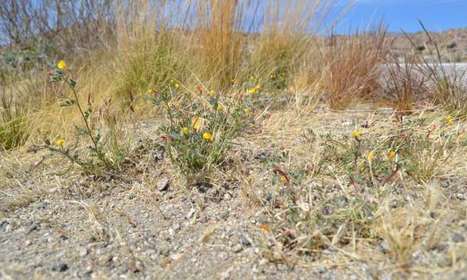


 Your new post is loading...
Your new post is loading...
